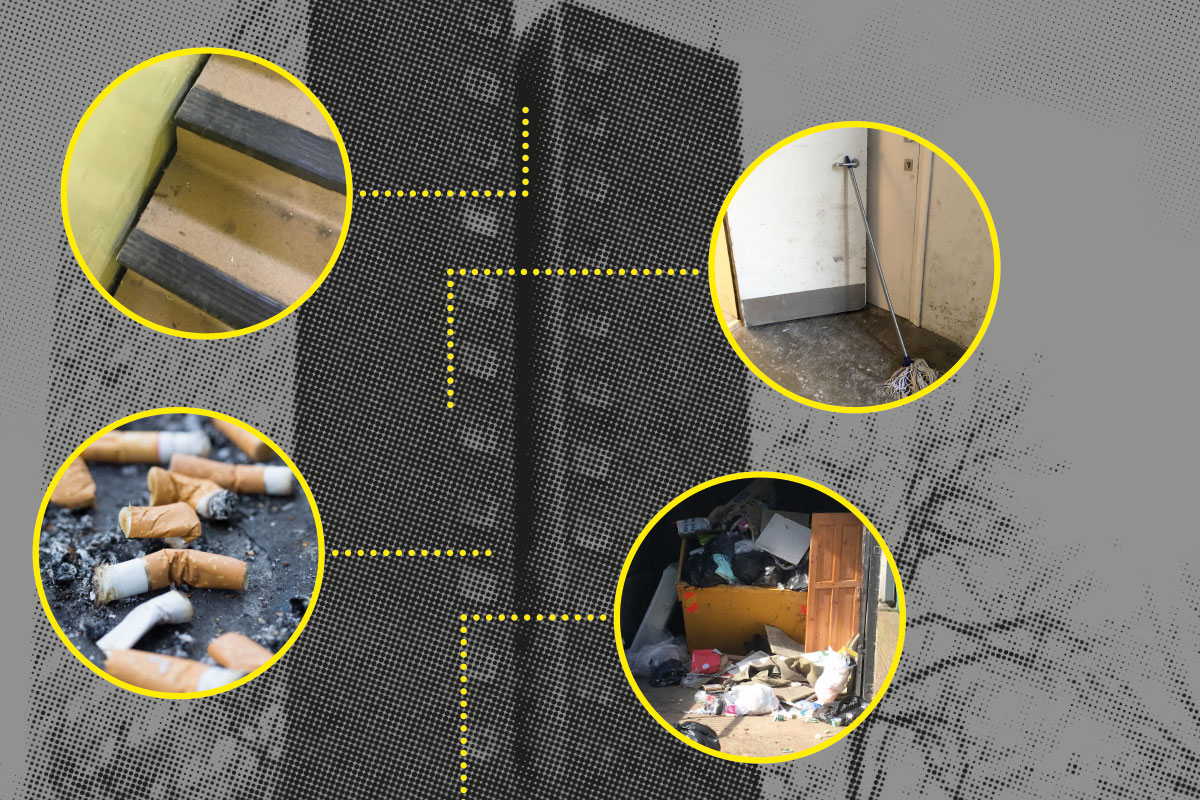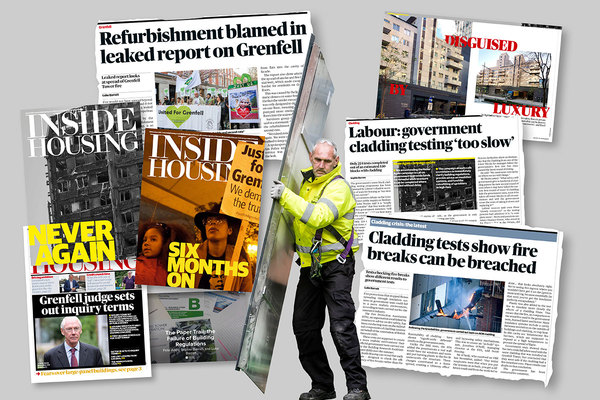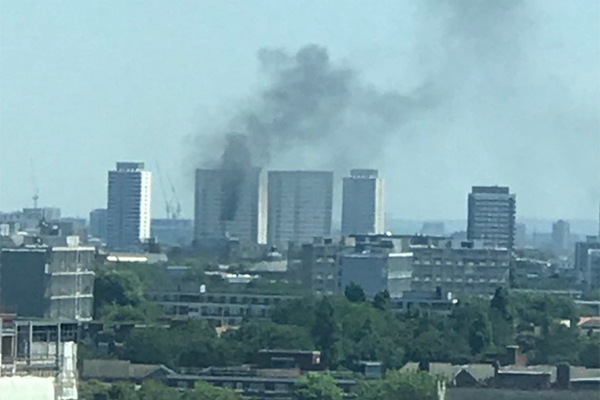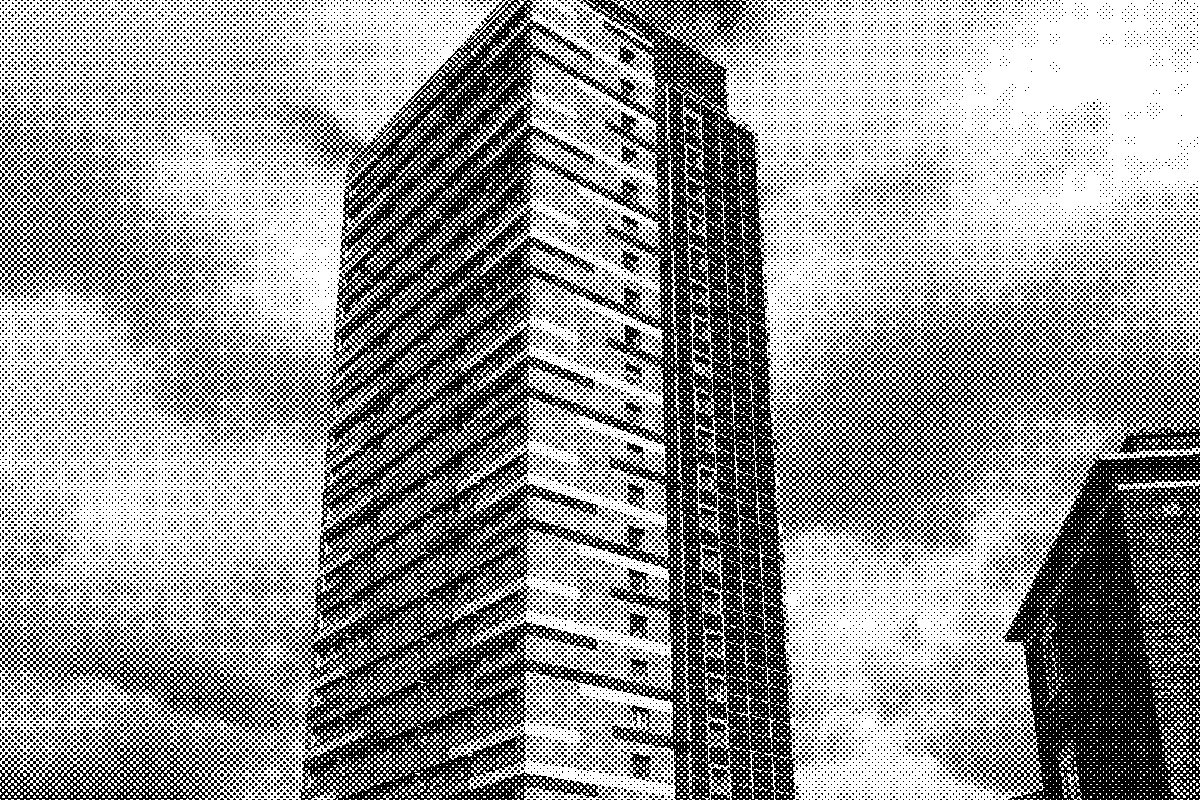You are viewing 1 of your 1 free articles
The biggest ever survey of fire risk assessments has revealed widespread safety problems
Inside Housing has obtained and analysed risk assessments for 1,584 tower blocks. One year on from the Grenfell tragedy, Sophie Barnes reveals the worrying problems they flag and the lessons they contain for social landlords. Photography by Danny Robinson
The first thing you notice outside Ilex House in north London is a huge pile of rubbish spilling out of a skip, nestled directly under the 17-storey block that stands alone among the Victorian terraces of Islington’s leafy streets.
A fire risk assessment of the block from May last year warns the skip should be moved because it is a fire hazard, but Inside Housing’s visit more than a year later shows it’s very much still in place. A short walk around the tower block reveals several other worrying fire safety issues, including fire doors being propped open with mops, gaps between the staircase and wall where smoke and flames could potentially pass through and cigarette butts in the stairways.
"A short walk around the tower block reveals several other worrying fire safety issues, including fire doors being propped open with mops."
The council states that gaps between stairs and the wall do not present a compartmentation risk, and that the new emergency lighting had been installed in the block two weeks ago.
Ilex House is far from unique. Instead, it serves as a useful example of the common fire safety issues in tower blocks across the country. In the most rigorous investigation of its kind, Inside Housing obtained fire risk assessments for 1,584 social housing tower blocks across England – 40% of the 4,000 social tower blocks in the UK.
The research has revealed widespread fire safety problems, with risk assessors reporting issues in 1,130 blocks that had either broken fire doors, or doors that would not provide 30 minutes’ resistance against fire.
Other serious issues include missing fire safety information in 712 blocks, which means residents are not always aware of what to do if a fire breaks out. In some blocks the fire safety advice is wrong, with residents being told to evacuate immediately if a fire breaks out when in fact the building has a ‘stay put’ policy. Emergency lighting to help residents in the event of a fire was either broken or missing in 402 blocks.
"In some blocks the fire safety advice is wrong, with residents being told to evacuate immediately if a fire breaks out when in fact the building has a ‘stay put’ policy."
There are 385 blocks – 24% – where compartmentation has been breached because of holes in walls or ceilings. This would mean that a stay put policy would not necessarily work because fire and smoke could spread between flats. However, in some of these same blocks older people are housed on the upper floors and assessors noted they would struggle to escape if a fire broke out.
This issue was brought into stark clarity at the recent Grenfell Inquiry commemoration hearings when Sakineh Afrasiabi’s daughter said her partially sighted mother had been forced to live on the 18th floor of the tower and did not escape on the night of the fire.
"It’s become so chaotic now that you’ve got fire services sending fire safety staff round to people that have got disabilities to give them reassurance."
Phil Murphy is a former fire safety officer for the Greater Manchester Fire and Rescue Service, and has been campaigning on tenants’ rights in relation to fire safety. He says there’s an issue with evacuation procedures for vulnerable people in tower blocks. “There are now a lot of disabled people – I have got a blind neighbour, a deaf neighbour and one who uses a wheelchair. It’s become so chaotic now that you’ve got fire services sending fire safety staff round to people that have got disabilities to give them reassurance. That’s the landlord’s job. So in fact the landlord is no longer looking after the safety of some of the tenants – the fire service has been asked to do it. We need to see an evacuation strategy for every person in every building, so if the worst comes to the worst you can get out. That’s the bottom line.”
A fire safety academic, who asked to remain anonymous, says tackling these issues should be an urgent priority if a landlord has a stay put policy in place.
“These are issues that really have to be addressed because if you’re running a stay put policy then you’ve got to ensure that you’ve got appropriate fire protection in your building and it’s maintained and inspected on a regular basis.”
In four of the blocks owned by Stoke-on-Trent City Council, vulnerable people were found to be living on the upper floors, which was against the council’s own policy. In these same blocks concerning findings included live electrical cables lying in pools of water in one tower block and shafts that run the entire height of the buildings that may not be protected from flames and smoke.
Inside Housing carried out a similar survey last year, immediately after the Grenfell Tower fire, looking at 436 tower blocks’ fire risk assessments. Our latest research reveals that many landlords have not carried out a fire risk assessment since the Grenfell Tower fire. In response to a Freedom of Information Act request asking councils and housing associations for the latest fire risk assessments 853, or 54%, were dated before the fire that claimed 72 lives in June last year.
“For a quarter of a million people [Grenfell has] changed absolutely nothing.” - Phil Murphy, Greater Manchester Fire and Rescue Service
Mr Murphy is unequivocal about the failure of landlords to carry out fire risk assessments since the Grenfell Tower fire. “You’re probably talking about a quarter of a million people there and the landlords have simply chosen business as usual – that’s what that says to me.
“There were quite a few prominent voices after the fire last June who said: ‘This changes everything’. Well, do you know what? For that quarter of a million people it’s changed absolutely nothing.
“Residents are sat there wondering what their blocks are like and if the landlord can’t even be bothered to react with a thorough risk assessment to nail the issues in their own blocks then they’re playing fast and loose with people’s safety.”
Brian Robinson, president of the Fire Sector Federation, which represents fire and rescue services, says the construction industry is taking the issue with combustible cladding seriously now, but wider fire safety issues are being left behind. “We’re finding in the industry generally now builders are saying, ‘Ooh steady on, we better not have anything that’s combustible because we might get caught with it’. But the people who are responsible for the upkeep of the building and the people responsible for the fire management – why haven’t they done something?”
Housing associations were reluctant to share the fire risk assessments for their tower blocks, despite being encouraged to do so by Elizabeth Denham, the Information Commissioner. Last August, two months after the Grenfell Tower fire, Ms Denham wrote in a blog post: “Unless there is a good reason not to, I urge public organisations holding relevant fire risk assessments and other fire safety information to consider publishing these records proactively.”
Despite this clear call to action only 13 housing associations out of 94 social landlords shared their fire risk assessments, in contrast with 61 councils and 20 ALMOs.
"Despite this clear call to action only 13 housing associations out of 94 social landlords shared their fire risk assessments, in contrast with 61 councils and 20 ALMOs."
Official guidance from the Local Government Association recommends blocks are assessed annually, and this was recently reiterated by Dame Judith Hackitt. But our investigation revealed 351 blocks – or 31% of the blocks for which assessment dates were provided – had either not had an annual assessment in the past few years or the assessor recommended the next one should be carried out two or more years in the future.
In her recent review into building regulations and fire safety, Dame Judith said fire risk assessments should be carried out “at least annually and when any significant alterations are made to the building”. In the current landscape, Dame Judith said fire risk assessments are “frequently inadequate or not completed at all”. Where they are carried out they “often consist of little more than a ‘tick box’ exercise undertaken by someone without demonstrable competence of fire safety and without consideration of:
- Whether fire safety measures may have been removed or damaged within flats;
- Whether residents are aware of the fire safety measures in place; or
- What the original design intent was in relation to fire safety”.
She stressed that the person carrying out these assessments should be “competent (with the right skills, knowledge and experience)”, but that this “should not be mandated by government… it should be for the dutyholder to set out how they satisfied themselves that the fire risk assessor had the required skills, knowledge and experience to work on their building”.
On the Hackitt Review Hannah Mansell, chair of the Passive Fire Protection Forum (PFPF), says: “I don’t think that we can be naive [enough] to think that these sectors are in a position to be able to police themselves. The culture of cutting a few corners and saving a few quid is ingrained, and it has got to stop now.”
The stark findings don’t come as a shock to the experts Inside Housing speaks to because fire safety has been neglected for many years. For Ms Mansell, who is familiar with the fire safety issues in residential buildings through her role with the PFPF, the widespread problems with fire doors show “a legacy of neglect”. She adds: “We’ve got decades to deal with, across a broad range of building profiles.”
“We would be naive to think these industries are in a position to police themselves.” - Hannah Mansell, Passive Fire Protection Forum (PFPF)
The Fire Sector Federation’s Mr Robinson says: “I think the issue with compartmentation is a real standard one. If you get plumbers, electricians, you name it, coming into a building the first thought on their mind isn’t fire safety. It’s actually, ‘Let’s get the job done’, and the worst thing that can happen is they punch a hole in the wall and then fill it up with magic foam – which is flammable. It’s legion.”
He adds: “In my view, if the house or the building was being managed properly then those things would be picked up by the managing agency or the owners and should be put straight.”
One senior fire safety expert, with years of frontline firefighting experience under his belt, is damning in his assessment of the importance placed on fire safety in the UK. “We are in a terrible place because fire safety is shot at the moment. It’s not been a priority, people haven’t thought about it, all sorts of actions have been taken that have infringed on fire safety. I agree with everything Hackitt said, but just to take us to the edge of the cliff and go, ‘Over to you, government’ – what’s that going to do? There’s no interim plan, there are no temporary arrangements, there’s nothing.”
The problems uncovered through this survey could only be scratching the surface, because assessors aren’t required to look at things like the cladding on the outside of the buildings.
As Ms Mansell says: “The majority of risk assessments note parts of the building fabric that are inaccessible to inspect. In this case there may be a number of ‘unknown’ risks. These risks are never recorded or accounted for in the development of the fire strategy for the building, or factored into any recommendations to mitigate the risk. I’ve seen assessments where I would take the view that the blocks have significant fire safety issues but the assessor marks it up as a low priority. These issues often don’t get sorted in a timely fashion, if ever.”















